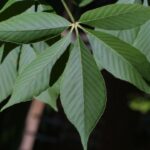Botanical Name:
Aesculus glabra
Family Name:
Sapindaceae
Description:
The Ohio buckeye is a medium-sized deciduous tree with a rounded crown, low, sweeping branches, and dense foliage. The tree is well known for its dark, reddish brown seeds that have a light colored “eye” at one end. It forms a deep taproot that makes it difficult to transplant successfully.
Size:
20-40’ tall; 20-40’ spread
Habitat and Range:
The native range of Ohio buckeye stretches in a northeast to southwest direction from Ohio through Indiana and Illinois into Missouri, eastern Oklahoma, and northern Texas. Its favored habitats are mesic woodlands, often in ravines or river valleys, but also in sheltered areas of more upland rocky slopes.
Attributes:
Leaves are opposite on the twigs and palmately compound with 5-7 leaflets. They usually turn yellow in the autumn, but can also sometimes turn orange or red. Elongated, upright clusters of 1” greenish-yellow flowers are produced in mid- to late spring. Relatively few fruits are produced, but they are distinctive – globose capsules with spiny, leathery coverings. Each fruit contains 1-2 seeds that are dark reddish-brown with a light colored “eye” at one end.
Wildlife Value:
Flowers are visited by hummingbirds and several bee species. Because the leaves and fruits are poisonous, few mammals use the Ohio buckeye as a food source.
Did you know?
• The name buckeye refers to the dark brown seed, which Native Americans likened to the eye of a buck deer.
• This is the state tree of Ohio, with its adopted nickname of the Buckeye State.
• The tree is also sometimes referred to as the fetid buckeye because flowers, leaves, and twigs emit a fetid odor when crushed.
Benefits to Our Community (based on carbon dioxide sequestered, storm water runoff avoided, and air pollution removed each year):
Over the next 15 years, this tree will give back $90 worth of benefits to our community.





